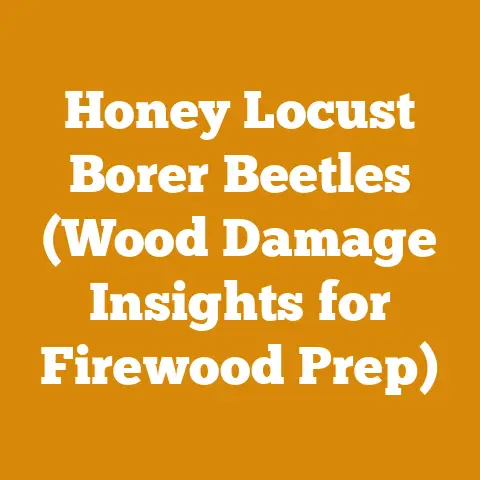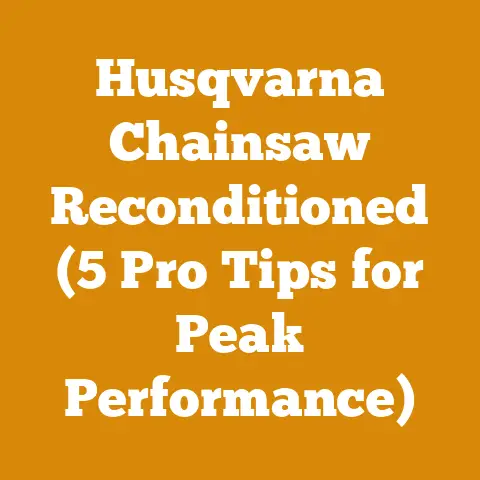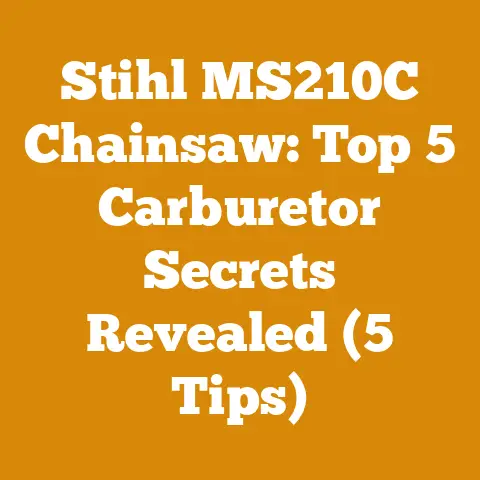What Kills Pine Beetles: Saving Infested Pines (Wood Rescue Tips)
Ah, that feeling when the wood stove is roaring, a cup of hot cocoa is in hand, and the scent of burning pine fills the air.
Pure bliss, isn’t it?
But that comfort can quickly turn to concern when you notice your beautiful pines falling victim to those tiny, yet destructive, creatures: pine beetles.
I’ve seen firsthand the devastation they can wreak, and it’s heartbreaking.
But don’t despair!
There are ways to fight back, to save your trees, and even salvage the wood.
This guide is about understanding “What Kills Pine Beetles,” learning to rescue infested pines, and turning a potential loss into a valuable resource.
What Kills Pine Beetles: Saving Infested Pines (Wood Rescue Tips)
Understanding the Enemy: Pine Beetle Biology and Behavior
Before we can effectively combat pine beetles, we need to understand their life cycle and behavior.
These aren’t just any bugs; they’re specialized killers of pine trees.
There are various species, but the most common culprits are the bark beetles, like the Mountain Pine Beetle (MPB), Southern Pine Beetle (SPB), and Ips beetles.
I’ve dealt with all three, each with its own quirks.
- Life Cycle: Pine beetles have a life cycle that typically lasts one year, though this can vary depending on the climate.
Adults bore into the bark of pine trees, creating tunnels (galleries) where they lay their eggs.
The larvae hatch and feed on the phloem, the inner bark that transports nutrients.
This disrupts the tree’s vascular system, effectively starving it. - Aggregation Pheromones: One of the most insidious aspects of pine beetle behavior is their use of aggregation pheromones.
When a few beetles find a suitable tree, they release these chemicals, attracting thousands more.
This mass attack overwhelms the tree’s defenses. - Blue Stain Fungus: Bark beetles often carry a symbiotic fungus called blue stain fungus.
This fungus grows within the tree’s vascular system, further hindering water and nutrient transport.
The fungus gives the wood a characteristic bluish-gray discoloration, which, while aesthetically interesting to some, significantly reduces the wood’s structural integrity.
Identifying Pine Beetle Infestation: Early Detection is Key
Early detection is crucial for saving infested pines.
The sooner you identify an infestation, the better your chances of taking effective action.
I’ve learned to be vigilant, constantly scanning my trees for telltale signs.
- Pitch Tubes: These are small, resinous masses that form on the trunk of the tree where beetles have bored in.
The tree attempts to defend itself by pushing out resin to drown the beetles.
However, in a mass attack, the tree is usually overwhelmed.- Technical Note: Pitch tubes are most visible on the lower trunk of the tree, typically within the first 10-15 feet.
- Frass: This is a mixture of beetle excrement and sawdust that accumulates in bark crevices and around the base of the tree.
It’s a telltale sign that beetles are actively boring into the wood. - Needle Discoloration: As the tree’s vascular system is damaged, the needles will start to change color.
Initially, they may turn yellowish-green, then reddish-brown.
This process can take several months. - Woodpecker Activity: Woodpeckers often feed on pine beetle larvae, so increased woodpecker activity on pine trees can be an indicator of infestation.
I’ve often followed the sound of woodpeckers to discover new infestations. - Crown Thinning: In advanced stages of infestation, the tree’s crown will start to thin, with needles falling off.
This is a sign that the tree is severely stressed and may not be salvageable.
What Kills Pine Beetles: Control and Prevention Methods
Now, let’s get to the heart of the matter: what kills pine beetles and how can we protect our trees?
There’s no silver bullet, but a combination of methods can be effective.
1. Preventive Measures: Keeping Your Trees Healthy
Prevention is always better than cure.
Healthy trees are more resistant to pine beetle attacks.
I always say, “A healthy tree is a happy tree, and a happy tree is a beetle-resistant tree!”
- Maintain Tree Vigor: Ensure your trees have adequate water, nutrients, and sunlight.
Proper watering during dry periods is essential.
Fertilize as needed, based on soil tests. - Thinning: Overcrowded stands of trees are more susceptible to beetle attacks.
Thinning reduces competition for resources and improves air circulation.- Technical Note: Aim for a basal area of 80-120 square feet per acre, depending on the species and site conditions.
Basal area is the total cross-sectional area of all trees at breast height (4.5 feet above ground).
- Technical Note: Aim for a basal area of 80-120 square feet per acre, depending on the species and site conditions.
- Sanitation: Remove dead, dying, or weakened trees promptly.
These trees are prime targets for pine beetles and can serve as breeding grounds. - Avoid Wounding Trees: Wounds can attract beetles.
Be careful when mowing, trimming, or logging near pine trees.
If a tree is wounded, seal the wound with a tree wound sealant.
2. Direct Control Methods: Attacking the Beetles
When prevention fails, direct control methods are necessary.
These methods aim to kill the beetles directly or prevent them from spreading.
- Insecticides: Insecticides can be used to protect individual trees from pine beetle attacks.
However, they are not a long-term solution and should be used judiciously.- Technical Note: The most effective insecticides are those containing pyrethroids, such as permethrin or bifenthrin.
These insecticides are applied to the bark of the tree, creating a protective barrier. - Safety Note: Always follow the manufacturer’s instructions carefully when using insecticides.
Wear appropriate protective gear, including gloves, eye protection, and a respirator.
- Technical Note: The most effective insecticides are those containing pyrethroids, such as permethrin or bifenthrin.
- Cut-and-Remove: This involves cutting down infested trees and removing them from the area.
This method is most effective when the infestation is localized and the beetles are still within the tree.- Technical Note: Cut trees should be disposed of properly.
Options include burning, chipping, or burying.
If burning, ensure you comply with local regulations and obtain any necessary permits. - Personal Experience: I once had to cut down a dozen infested trees on my property.
It was a lot of work, but it prevented the infestation from spreading to healthy trees.
I used a chainsaw with a 20-inch bar and wore full safety gear, including a helmet, eye protection, ear protection, and chaps.
- Technical Note: Cut trees should be disposed of properly.
- Mill and Kiln Dry: If trees are recently infested, milling the lumber and then kiln drying it to below 20% moisture content will kill the beetles and their larvae.
- Solar Barking: This method involves felling the infested trees and leaving them in a sunny location with the bark exposed to the sun.
The heat from the sun can kill the beetles.
3. Biological Control: Using Natural Enemies
Biological control involves using natural enemies of pine beetles to control their populations.
This is a more sustainable approach than using insecticides.
- Predatory Insects: Several insects prey on pine beetles, including bark beetle predators like checkered beetles (Cleridae) and predatory flies (Medetera).
Encourage these beneficial insects by providing suitable habitat, such as flowering plants that provide nectar and pollen. - Parasitic Wasps: Some species of parasitic wasps lay their eggs inside pine beetle larvae, killing them.
- Fungal Pathogens: Certain fungi, such as Beauveria bassiana, can infect and kill pine beetles.
These fungi can be applied as a bio-insecticide.
4. Pheromone Baits: Confusing the Beetles
Pheromone baits can be used to disrupt pine beetle aggregation.
These baits release synthetic pheromones that either attract beetles to a specific location (where they can be trapped or killed) or confuse them, preventing them from finding suitable host trees.
- Anti-Aggregation Pheromones: These pheromones disrupt the aggregation process, preventing beetles from mass attacking trees.
- Aggregation Pheromone Traps: These traps attract beetles to a specific location, where they can be captured and killed.
Wood Rescue: Salvaging Value from Infested Trees
Even if you can’t save all your trees, you can still salvage value from the infested wood.
Pine beetle-killed wood can be used for a variety of purposes, from firewood to lumber.
1. Assessing the Wood: Is it Still Usable?
The first step is to assess the wood to determine its suitability for different uses.
Factors to consider include the extent of beetle damage, the presence of blue stain fungus, and the moisture content of the wood.
- Blue Stain Fungus: While blue stain fungus doesn’t significantly affect the structural strength of the wood, it can make it more brittle and difficult to work with.
Wood with heavy blue stain may be more suitable for firewood than for lumber.- Technical Note: Blue stain fungus is most prevalent in the sapwood, the outer layer of wood.
The heartwood, the inner layer of wood, is generally more resistant to fungal attack.
- Technical Note: Blue stain fungus is most prevalent in the sapwood, the outer layer of wood.
- Moisture Content: The moisture content of the wood is critical for determining its suitability for different uses.
Green wood (freshly cut wood) has a high moisture content and is prone to warping and cracking as it dries.
Kiln-dried wood has a low moisture content and is more stable.- Technical Note: The moisture content of wood is expressed as a percentage of the oven-dry weight of the wood.
For example, wood with a moisture content of 20% contains 20 pounds of water for every 100 pounds of oven-dry wood. - Industry Standard: For framing lumber, the industry standard moisture content is 19% or less.
For furniture-grade lumber, the moisture content is typically 6-8%.
- Technical Note: The moisture content of wood is expressed as a percentage of the oven-dry weight of the wood.
2. Firewood: A Practical Use for Infested Wood
Pine beetle-killed wood makes excellent firewood.
It burns hot and fast, making it ideal for heating homes.
- Seasoning Firewood: Seasoning is the process of drying firewood to reduce its moisture content.
Properly seasoned firewood burns more efficiently and produces less smoke.- Technical Note: Firewood should be seasoned for at least six months, preferably a year.
Stack the wood in a sunny, well-ventilated location.
Cover the top of the stack to protect it from rain and snow. - Personal Tip: I always stack my firewood on pallets to keep it off the ground and improve air circulation.
- Technical Note: Firewood should be seasoned for at least six months, preferably a year.
- Safety Precautions: When cutting and splitting firewood, always wear appropriate safety gear, including a helmet, eye protection, ear protection, gloves, and steel-toed boots.
Use a chainsaw with caution and follow all safety guidelines.
3. Milling Lumber: Turning Infested Trees into Valuable Resources
Pine beetle-killed wood can be milled into lumber for a variety of uses, including furniture, flooring, and construction.
- Sawmills: If you have a large quantity of infested wood, consider hiring a local sawmill to mill it into lumber.
- Portable Sawmills: Portable sawmills are a convenient option for milling wood on-site.
These mills can be rented or purchased. - Kiln Drying: Kiln drying is essential for producing high-quality lumber from pine beetle-killed wood.
Kiln drying reduces the moisture content of the wood, making it more stable and resistant to decay.- Technical Note: Kiln drying involves heating the wood in a controlled environment to remove moisture.
The temperature and humidity are carefully regulated to prevent warping and cracking. - Industry Standard: Kiln-dried lumber should have a moisture content of 19% or less for framing lumber and 6-8% for furniture-grade lumber.
- Technical Note: Kiln drying involves heating the wood in a controlled environment to remove moisture.
- Wood Characteristics: Pine beetle-killed wood often has a unique blue stain, which can add character to the lumber.
Some people find the blue stain aesthetically pleasing, while others prefer wood without it.
4. Other Uses: Exploring Creative Options
Pine beetle-killed wood can also be used for a variety of other purposes, including:
- Wood Chips: Wood chips can be used for landscaping, mulching, or as a fuel source for biomass boilers.
- Pulpwood: Pine beetle-killed wood can be used to make pulp for paper production.
- Craft Projects: Small pieces of pine beetle-killed wood can be used for craft projects, such as wood carvings, picture frames, and decorative items.
- Biochar: Pine beetle-killed wood can be converted into biochar, a charcoal-like substance that can be used as a soil amendment.
Safety First: Protecting Yourself During Wood Rescue
Wood rescue can be dangerous work.
It’s essential to take safety precautions to protect yourself from injury.
- Personal Protective Equipment (PPE): Always wear appropriate PPE, including a helmet, eye protection, ear protection, gloves, steel-toed boots, and chaps when working with chainsaws or other power tools.
- Chainsaw Safety: Chainsaws are powerful tools that can cause serious injury if used improperly.
Follow all safety guidelines and instructions provided by the manufacturer.- Technical Note: Chainsaw chains should be sharpened regularly to ensure optimal performance and safety.
Dull chains are more likely to kick back, which can cause serious injury. - Safety Tip: Never operate a chainsaw when you are tired, under the influence of drugs or alcohol, or in poor lighting conditions.
- Technical Note: Chainsaw chains should be sharpened regularly to ensure optimal performance and safety.
- Lifting Techniques: Use proper lifting techniques to avoid back injuries.
Bend your knees, keep your back straight, and lift with your legs. - Working at Heights: Avoid working at heights whenever possible.
If you must work at heights, use a ladder or aerial lift and wear a safety harness. - Hazard Trees: Be aware of the dangers of hazard trees, which are trees that are dead, dying, or structurally unsound.
These trees can fall without warning and cause serious injury or death.- Safety Tip: If you are unsure about the stability of a tree, consult with a professional arborist.
Case Studies: Learning from Real-World Examples
To illustrate the principles discussed in this guide, let’s look at a few case studies of successful pine beetle control and wood rescue projects.
Case Study 1: Community-Wide Pine Beetle Management Program
In a small mountain town in Colorado, a community-wide pine beetle management program was implemented to protect the town’s forests from a devastating MPB outbreak.
The program involved a combination of preventive measures, direct control methods, and wood utilization initiatives.
- Preventive Measures: The town implemented a thinning program to reduce tree density and improve tree vigor.
They also provided education and outreach to homeowners on how to protect their trees. - Direct Control Methods: The town used insecticides to protect high-value trees, such as those near homes and businesses.
They also implemented a cut-and-remove program to remove infested trees. - Wood Utilization: The town partnered with a local sawmill to mill infested trees into lumber.
The lumber was used for a variety of projects, including building affordable housing and renovating public buildings. - Results: The program was highly successful in reducing the spread of the MPB and protecting the town’s forests.
The wood utilization component of the program also provided economic benefits to the community.
Case Study 2: Salvaging Pine Beetle-Killed Wood for Furniture Production
A furniture maker in Montana developed a business model based on salvaging pine beetle-killed wood.
The furniture maker used the wood to create unique, high-quality furniture pieces that were sold to customers across the country.
- Sourcing Wood: The furniture maker sourced pine beetle-killed wood from local landowners and logging companies.
- Processing Wood: The wood was milled into lumber and kiln-dried to reduce moisture content.
The furniture maker carefully selected pieces of wood with interesting blue stain patterns. - Furniture Design: The furniture maker designed furniture pieces that showcased the unique character of the pine beetle-killed wood.
- Marketing and Sales: The furniture maker marketed the furniture pieces as sustainable and environmentally friendly.
The furniture was sold online and through retail outlets. - Results: The furniture maker’s business was highly successful.
The company created jobs, supported local landowners and logging companies, and produced beautiful, sustainable furniture.
Staying Updated: Following the Latest Research and Best Practices
Pine beetle management and wood rescue are constantly evolving fields.
It’s essential to stay updated on the latest research and best practices.
- Forestry Agencies: Follow the websites and publications of your local and national forestry agencies.
These agencies provide valuable information on pine beetle management and wood utilization. - Universities: Many universities conduct research on pine beetles and wood utilization.
Follow the websites of these universities to stay updated on the latest findings. - Industry Associations: Join relevant industry associations, such as the Society of American Foresters or the National Hardwood Lumber Association.
These associations provide opportunities for networking and learning about the latest industry trends. - Workshops and Conferences: Attend workshops and conferences on pine beetle management and wood rescue.
These events provide opportunities to learn from experts and network with other professionals.
Conclusion: Turning a Challenge into an Opportunity
Pine beetle infestations are a serious threat to our forests, but they also present an opportunity to be resourceful and innovative.
By understanding the biology and behavior of pine beetles, implementing effective control methods, and salvaging value from infested wood, we can protect our forests and create valuable resources.
It’s a challenging task, but with knowledge, dedication, and a bit of elbow grease, we can turn this threat into an opportunity.
And who knows, maybe you’ll even find a new appreciation for the unique beauty of blue-stained pine!






